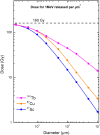Comparison between Three Promising ß-emitting Radionuclides, (67)Cu, (47)Sc and (161)Tb, with Emphasis on Doses Delivered to Minimal Residual Disease
- PMID: 27446495
- PMCID: PMC4955060
- DOI: 10.7150/thno.15132
Comparison between Three Promising ß-emitting Radionuclides, (67)Cu, (47)Sc and (161)Tb, with Emphasis on Doses Delivered to Minimal Residual Disease
Abstract
Purpose: Radionuclide therapy is increasingly seen as a promising option to target minimal residual disease. Copper-67, scandium-47 and terbium-161 have a medium-energy β(-) emission which is similar to that of lutetium-177, but offer the advantage of having diagnostic partner isotopes suitable for pretreatment imaging. The aim of this study was to compare the efficacy of (67)Cu, (47)Sc and (161)Tb to irradiate small tumors.
Methods: The absorbed dose deriving from a homogeneous distribution of (67)Cu, (47)Sc or (161)Tb in water-density spheres was calculated with the Monte Carlo code CELLDOSE. The diameters of the spheres ranged from 5 mm to 10 µm, thus simulating micrometastases or single tumor cells. All electron emissions, including β(-) spectra, Auger and conversion electrons were taken into account. Because these radionuclides differ in electron energy per decay, the simulations were run assuming that 1 MeV was released per µm(3), which would result in a dose of 160 Gy if totally absorbed.
Results: The absorbed dose was similar for the three radionuclides in the 5-mm sphere (146-149 Gy), but decreased differently in smaller spheres. In particular, (161)Tb delivered higher doses compared to the other radionuclides. For instance, in the 100-µm sphere, the absorbed dose was 24.1 Gy with (67)Cu, 14.8 Gy with (47)Sc and 44.5 Gy with (161)Tb. Auger and conversion electrons accounted for 71% of (161)Tb dose. The largest dose differences were found in cell-sized spheres. In the 10-µm sphere, the dose delivered by (161)Tb was 4.1 times higher than that from (67)Cu and 8.1 times that from (47)Sc.
Conclusion: (161)Tb can effectively irradiate small tumors thanks to its decay spectrum that combines medium-energy β(-) emission and low-energy conversion and Auger electrons. Therefore (161)Tb might be a better candidate than (67)Cu and (47)Sc for treating minimal residual disease in a clinical setting.
Keywords: Dose; copper-67; lutetium-177.; micrometastases; minimal residual disease; radionuclide therapy; scandium-47; terbium-161.
Conflict of interest statement
Competing Interests: The authors have declared that no competing interest exists.
Figures




References
-
- Volkert WA, Hoffman TJ. Therapeutic radiopharmaceuticals. Chem Rev. 1999;99:2269–92. - PubMed
-
- Mazzaferri EL, Jhiang SM. Long-term impact of initial surgical and medical therapy on papillary and follicular thyroid cancer. Am J Med. 1994;97:418–28. - PubMed
-
- Hindié E, Mellière D, Lange F. et al. Functioning pulmonary metastases of thyroid cancer: does radioiodine influence the prognosis? Eur J Nucl Med Mol Imaging. 2003;30:974–81. - PubMed
-
- Hindié E, Zanotti-Fregonara P, Keller I. et al. Bone metastases of differentiated thyroid cancer: impact of early 131I-based detection on outcome. Endocr Relat Cancer. 2007;14:799–807. - PubMed
-
- Witzig TE, Gordon LI, Cabanillas F. et al. Randomized controlled trial of yttrium-90-labeled ibritumomab tiuxetan radioimmunotherapy versus rituximab immunotherapy for patients with relapsed or refractory low-grade, follicular, or transformed B-cell non-Hodgkin's lymphoma. J Clin Oncol. 2002;20:2453–63. - PubMed
Publication types
MeSH terms
Substances
LinkOut - more resources
Full Text Sources
Other Literature Sources

